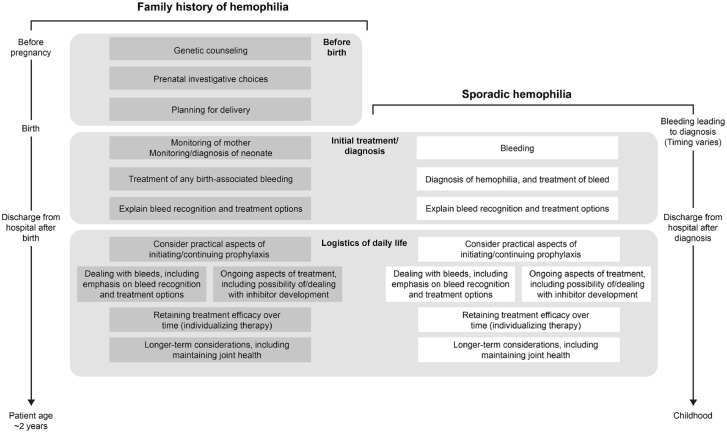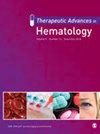先前未经治疗的A或B型血友病患者共同决策管理的考虑。
摘要
治疗方法的最新进展现在为患有血友病的成人和儿童提供了广泛的选择。尽管患有严重疾病的最年轻个体的治疗选择也在增加,但由于目前支持数据有限,早期管理决策仍然存在挑战。父母和保健专业人员的任务是帮助儿童实现包容性的生活质量,并在成年后保持良好的关节健康。初级预防是优化结果的黄金标准,建议在2岁之前开始。需要与父母讨论一系列的话题,以帮助他们理解他们可以做出的决定,以及这些决定将如何影响对孩子的管理。对于那些有血友病家族史的人,产前考虑包括遗传咨询、产前调查和分娩计划的可能性,以及对母亲和新生儿的监测,以及对新生儿的诊断和对任何与分娩有关的出血的治疗。随后的考虑也适用于婴儿出血导致散发性血友病新诊断的家庭,包括解释出血识别和治疗方案、开始/继续预防的实际方面、处理出血以及正在进行的治疗方面,包括可能的抑制剂开发。随着时间的推移,优化治疗效果,其中围绕活动的个性化治疗可以发挥作用,长期考虑,包括保持关节健康和耐受性维持,变得越来越重要。不断变化的治疗形势需要不断更新指南。来自患者组织的多学科团队和同行可以帮助提供相关信息。易于获得的多学科综合护理仍然是护理的基础。尽早为父母提供知识,以促进真正知情的决策,将有助于为患有血友病的儿童和家庭实现尽可能最佳的长期健康公平和生活质量。简明扼要的语言总结:帮助家庭做出决定,为患有血友病的儿童提供最佳护理应考虑的要点医学进步正在为患有血友病的成人和儿童提供一系列治疗选择。然而,关于如何处理新生儿此病的信息相对有限。医生和护士可以帮助父母了解患有血友病的婴儿的选择。我们描述了医生和护士应该理想地与家庭讨论,使知情的决策。我们的重点是需要早期治疗以防止自发性或外伤性出血(预防)的婴儿,建议在2岁之前开始。有血友病病史的家庭可以从怀孕前的讨论中受益,包括如何治疗受影响的孩子以防止出血。当母亲怀孕时,医生可以解释检查,可以提供有关未出生孩子的信息,计划分娩,并监测母亲和婴儿,以尽量减少分娩时出血的风险。检测将确认婴儿是否患有血友病。并非所有患有血友病的婴儿都出生在有血友病病史的家庭。首次在家庭中发现血友病(即“散发性血友病”)发生在以前未确诊的婴儿身上,这些婴儿出血需要医疗建议,可能需要住院治疗。在任何患有血友病的母亲和婴儿出院之前,医生和护士将向父母解释如何识别出血,并讨论可用的治疗方案。随着时间的推移,正在进行的讨论将帮助家长做出明智的治疗决定:•何时以及如何开始,然后继续预防。•如何处理出血(加强先前关于出血识别和治疗的讨论)和其他正在进行的治疗方面。〇例如,儿童可能对正在接受的治疗产生中和抗体(抑制剂),需要改变计划的方法。•考虑到孩子的不同需求和活动,确保治疗在孩子成长过程中保持有效。



Recent advances in therapeutics are now providing a wide range of options for adults and children living with hemophilia. Although therapeutic choices are also increasing for the youngest individuals with severe disease, challenges remain about early management decisions, as supporting data are currently limited. Parents and healthcare professionals are tasked with helping children achieve an inclusive quality of life and maintain good joint health into adulthood. Primary prophylaxis is the gold standard to optimize outcomes and is recommended to start before 2 years of age. A range of topics need to be discussed with parents to aid their understanding of the decisions they can make and how these will affect the management of their child/children. For those with a family history of hemophilia, prenatal considerations include the possibility of genetic counseling, prenatal investigations, and planning for delivery, together with monitoring of the mother and neonate, as well as diagnosis of the newborn and treatment of any birth-associated bleeding. Subsequent considerations, which are also applicable to families where infant bleeding has resulted in a new diagnosis of sporadic hemophilia, involve explaining bleed recognition and treatment options, practical aspects of initiating/continuing prophylaxis, dealing with bleeds, and ongoing aspects of treatment, including possible inhibitor development. Over time, optimizing treatment efficacy, in which individualizing therapy around activities can play a role, and long-term considerations, including retaining joint health and tolerance maintenance, become increasingly important. The evolving treatment landscape is creating a need for continually updated guidance. Multidisciplinary teams and peers from patient organizations can help provide relevant information. Easily accessible, multidisciplinary comprehensive care remains a foundation to care. Equipping parents early with the knowledge to facilitate truly informed decision-making will help achieve the best possible longer-term health equity and quality of life for the child and family living with hemophilia.
Plain language summary: Points to be taken into account to help families make decisions to best care for children born with hemophilia Medical advances are providing a range of treatment options for adults and children with hemophilia. There is, however, relatively limited information about managing newborns with the condition. Doctors and nurses can help parents to understand the choices for infants born with hemophilia. We describe the various points doctors and nurses should ideally discuss with families to enable informed decision-making. We focus on infants who require early treatment to prevent spontaneous or traumatic bleeding (prophylaxis), which is recommended to start before 2 years of age. Families with a history of hemophilia may benefit from discussions before pregnancy, including how an affected child would be treated to protect against bleeds. When mothers are pregnant, doctors can explain investigations that can provide information about their unborn child, plan for the birth, and monitor mother and baby to minimize bleed risks at delivery. Testing will confirm whether the baby is affected by hemophilia. Not all infants with hemophilia will be born to families with a history of the condition. Identification of hemophilia for the first time in a family (which is 'sporadic hemophilia') occurs in previously undiagnosed infants who have bleeds requiring medical advice and possibly hospital treatment. Before any mothers and babies with hemophilia are discharged from hospital, doctors and nurses will explain to parents how to recognize bleeding and available treatment options can be discussed. Over time, ongoing discussions will help parents to make informed treatment decisions:• When and how to start, then continue, prophylaxis.• How to deal with bleeds (reinforcing previous discussions about bleed recognition and treatment) and other ongoing aspects of treatment. ○ For instance, children may develop neutralizing antibodies (inhibitors) to treatment they are receiving, requiring a change to the planned approach.• Ensuring treatment remains effective as their child grows, considering the varied needs and activities of their child.

 求助内容:
求助内容: 应助结果提醒方式:
应助结果提醒方式:


